When we think of iconic American muscle cars and performance vehicles, Pontiac immediately roars to mind. This legendary brand dominated racetracks and highways for over eight decades, delivering pure driving excitement that defined generations of car enthusiasts. From the groundbreaking GTO that launched the muscle car era to the sleek Trans Am that became a Hollywood star, Pontiac’s legacy runs deep in automotive history.
We’ve witnessed how Pontiac transformed from a companion brand to General Motors’ performance division, consistently pushing boundaries with innovative engineering and bold designs. The brand’s commitment to power, style, and affordability created some of the most coveted vehicles ever produced.
Though Pontiac’s production ended in 2010, we’re still captivated by these remarkable machines that continue to command respect on collector car lots and drag strips worldwide. Let’s explore the fascinating journey of Pontiac cars and discover why they remain automotive legends today.
The Birth and Early Years of Pontiac Cars (1926-1940)
Pontiac’s journey began as General Motors’ strategic response to the changing automotive industry of the 1920s. We’ll explore how this ambitious brand established itself during its formative years and captured the hearts of American drivers.
General Motors’ Strategic Brand Positioning
General Motors launched Pontiac in 1926 to fill the crucial gap between Chevrolet and Oldsmobile in their pricing hierarchy. Alfred P. Sloan Jr., GM’s president, recognized that consumers wanted affordable vehicles with premium features and styling cues from higher-end brands.
Pontiac targeted middle-class buyers who desired more sophistication than Chevrolet offered but couldn’t afford Oldsmobile’s luxury pricing. The brand positioned itself as the “Chief of the Sixes,” emphasizing its six-cylinder engines when most competitors in the price range offered only four-cylinder power.
Marketing campaigns emphasized value engineering and Pontiac’s Native American heritage through its distinctive arrowhead logo and chief mascot hood ornament. GM’s advertising highlighted the brand’s combination of performance, reliability, and style at accessible price points.
Strategic partnerships with Oakland Motor Car Company initially produced Pontiac vehicles, leveraging existing manufacturing infrastructure while developing the brand’s identity. This approach allowed GM to test market acceptance without massive capital investments in new facilities.
First Models and Market Reception
The 1926 Pontiac Series 6-27 debuted as the brand’s inaugural model, featuring a 186.5-cubic-inch inline six-cylinder engine producing 40 horsepower. We saw immediate consumer interest in the vehicle’s combination of power and affordability, priced at just $825 for the coupe model.
Sales figures exceeded GM’s expectations with 76,742 Pontiac vehicles sold in the first year alone. The Series 6-27 offered four body styles including touring car, coupe, sedan, and sport roadster configurations to appeal to diverse buyer preferences.
Design innovations distinguished early Pontiacs from competitors through features like balloon tires, automatic windshield wipers, and coincidental lock systems. These premium touches typically found only on expensive vehicles helped justify Pontiac’s positioning above Chevrolet.
The 1927 model year brought refinements including improved suspension systems and updated styling that incorporated Art Deco influences popular during the era. Consumer response remained strong with sales climbing to 123,296 units.
Performance improvements continued through the 1930s as Pontiac introduced features like synchromesh transmissions, independent front suspension, and hydraulic brakes. The brand’s reputation for reliability and innovation attracted buyers seeking modern automotive technology without luxury car pricing.
Market reception during the Depression years proved Pontiac’s resilience as sales remained stable while many competitors struggled. The brand’s value proposition resonated with cost-conscious consumers who still wanted quality and style in their vehicle purchases.
Pontiac Cars During the Performance Era (1950s-1960s)
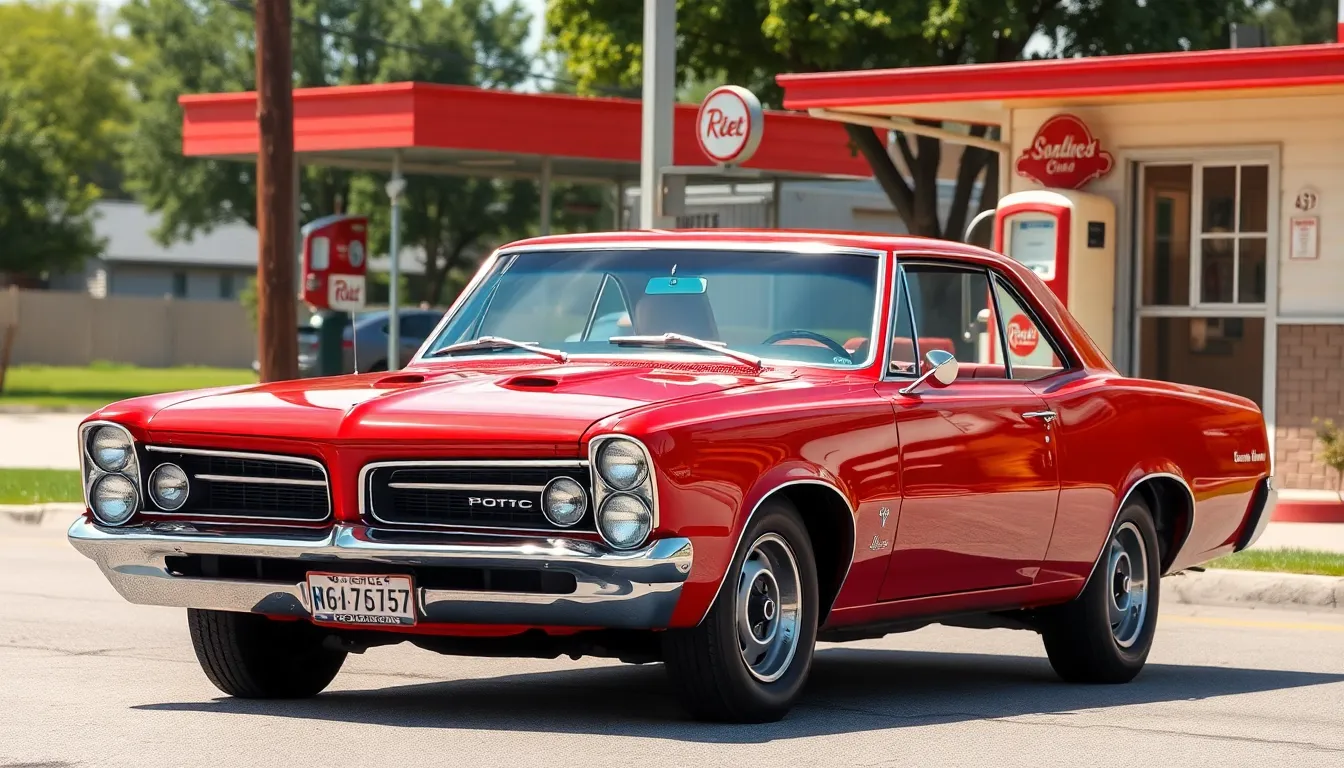
The 1950s marked Pontiac’s transformation from a value-oriented brand into America’s premier performance division. Revolutionary engineering innovations and bold design choices positioned Pontiac at the forefront of the emerging muscle car movement.
Introduction of the V8 Engine
Pontiac’s 287-cubic-inch V8 engine debuted in 1955, fundamentally changing the brand’s identity. Engineering teams developed this overhead valve powerplant to compete directly with Chevrolet’s small-block V8 and Chrysler’s FirePower Hemi engines. The new V8 produced 180 horsepower in standard form, while the four-barrel carburetor version generated 200 horsepower.
Performance enthusiasts immediately embraced Pontiac’s V8 technology for its unique design characteristics. Unlike other manufacturers, Pontiac engineers created all their V8 engines with the same 4.0625-inch bore spacing, allowing for easy displacement increases. This modular approach enabled the brand to expand engine sizes from 287 cubic inches to massive 455-cubic-inch big blocks without tooling changes.
Marketing campaigns emphasized Pontiac’s “Wide Track” stance and powerful V8 engines throughout the late 1950s. Sales figures reflected consumer enthusiasm, with Pontiac climbing from fifth to third place in industry rankings by 1962. The brand’s focus on performance attracted younger buyers who wanted affordable speed and style.
The GTO: Birth of the Muscle Car
Pontiac’s 1964 GTO created the muscle car formula that defined an entire automotive era. Chief engineer John DeLorean and his team circumvented GM’s corporate policy against installing large engines in intermediate cars by offering the 389-cubic-inch V8 as an option package on the Tempest. This brilliant strategy birthed the first true muscle car.
Initial projections estimated 5,000 GTO sales, but consumer demand reached 32,450 units in the first model year. The base GTO package included the 325-horsepower 389 V8, heavy-duty suspension components, dual exhaust systems, and distinctive styling cues like hood scoops and GTO badges. Optional equipment allowed buyers to specify the Tri-Power 389 engine producing 348 horsepower.
Advertising positioned the GTO as “The Great One,” targeting performance-minded younger buyers. Television commercials and magazine advertisements showcased the car’s acceleration capabilities and street credibility. The GTO’s success prompted every major American manufacturer to develop competing muscle cars, establishing a performance war that lasted through the early 1970s.
Racing success validated the GTO’s performance credentials on dragstrips and road courses nationwide. Professional drivers achieved consistent quarter-mile times in the low 14-second range, while modified versions broke into the 12-second territory. These achievements cemented Pontiac’s reputation as the brand for serious performance enthusiasts.
Iconic Pontiac Cars That Defined American Muscle
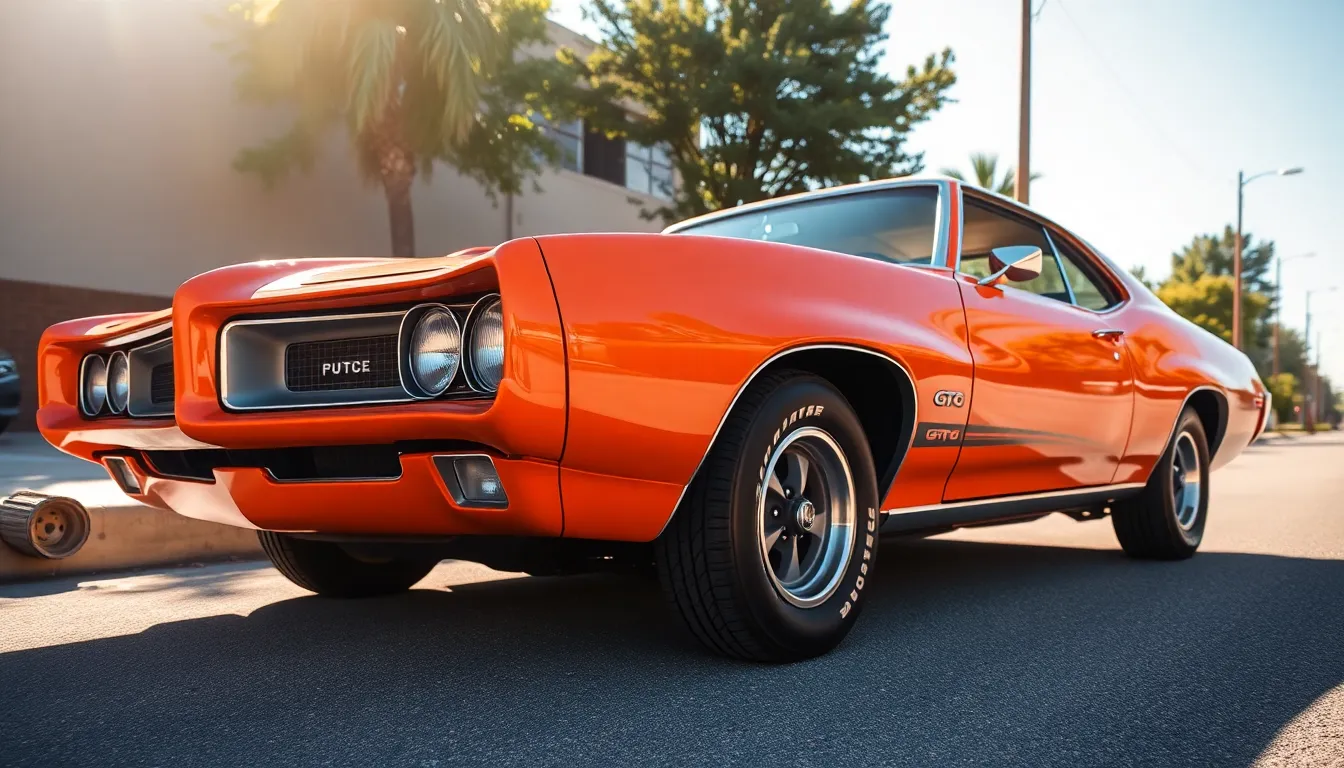
These legendary Pontiac models represent the pinnacle of American muscle car engineering and remain benchmarks for performance enthusiasts today.
Pontiac GTO: The Judge of Performance
Pontiac’s GTO revolutionized the muscle car industry when it debuted in 1964. Originally conceived as an option package for the Tempest, this groundbreaking vehicle combined a powerful 389 cubic inch V8 engine with a lightweight intermediate body. Marketing genius John DeLorean positioned the GTO as the first true muscle car, targeting young buyers who craved both style and substance.
Performance figures from the GTO speak volumes about its capabilities. The base 325 horsepower engine could propel the car from 0 to 60 mph in just 6.6 seconds, while the optional Tri Power setup delivered 348 horsepower. Sales exceeded all expectations, with over 32,000 units sold in its inaugural year alone.
Special editions like “The Judge” took GTO performance to extreme levels. Introduced in 1969, this variant featured the Ram Air IV 400 cubic inch engine producing 370 horsepower. Bold graphics, unique spoilers, and distinctive orange paint made The Judge instantly recognizable on streets and drag strips across America.
Trans Am: Firebird’s Crown Jewel
Trans Am emerged as Pontiac’s flagship performance car in 1969. Built on the Firebird platform, this model featured aggressive styling cues including a distinctive screaming chicken decal and functional hood scoops. The Trans Am’s combination of raw power and striking appearance made it a Hollywood favorite, starring in countless films and television shows.
Engine options for the Trans Am catered to serious performance enthusiasts. The Super Duty 455 engine, available from 1973 to 1974, produced an impressive 290 horsepower during the height of emission regulations. Later models featured the legendary 6.6 liter V8, maintaining Pontiac’s performance heritage through challenging regulatory periods.
Special editions elevated the Trans Am’s legendary status throughout its production run. The 10th Anniversary model of 1979 featured unique silver and charcoal paint with special graphics. The final 2002 Trans Am included the LS1 V8 engine producing 325 horsepower, marking the end of an era with exceptional performance credentials.
Grand Prix: Luxury Meets Power
Grand Prix established Pontiac’s presence in the personal luxury performance segment starting in 1962. This full size coupe combined elegant styling with powerful engine options, attracting buyers who wanted both comfort and performance. The Grand Prix featured distinctive long hood, short deck proportions that became synonymous with American grand touring cars.
Performance variants of the Grand Prix delivered impressive muscle car credentials. The 1970 Grand Prix SJ featured the 455 cubic inch V8 engine producing 370 horsepower, making it one of the most powerful luxury coupes available. Interior appointments included premium materials, bucket seats, and comprehensive instrumentation that rivaled European grand tourers.
Later generations maintained the Grand Prix’s performance legacy through innovative engineering. The 1988 Grand Prix introduced aerodynamic styling and advanced suspension systems, while turbocharged engines provided strong acceleration. NASCAR success throughout the 1980s and 1990s reinforced the Grand Prix’s reputation as a serious performance vehicle capable of dominating both streets and racetracks.
Pontiac Cars in Popular Culture and Media
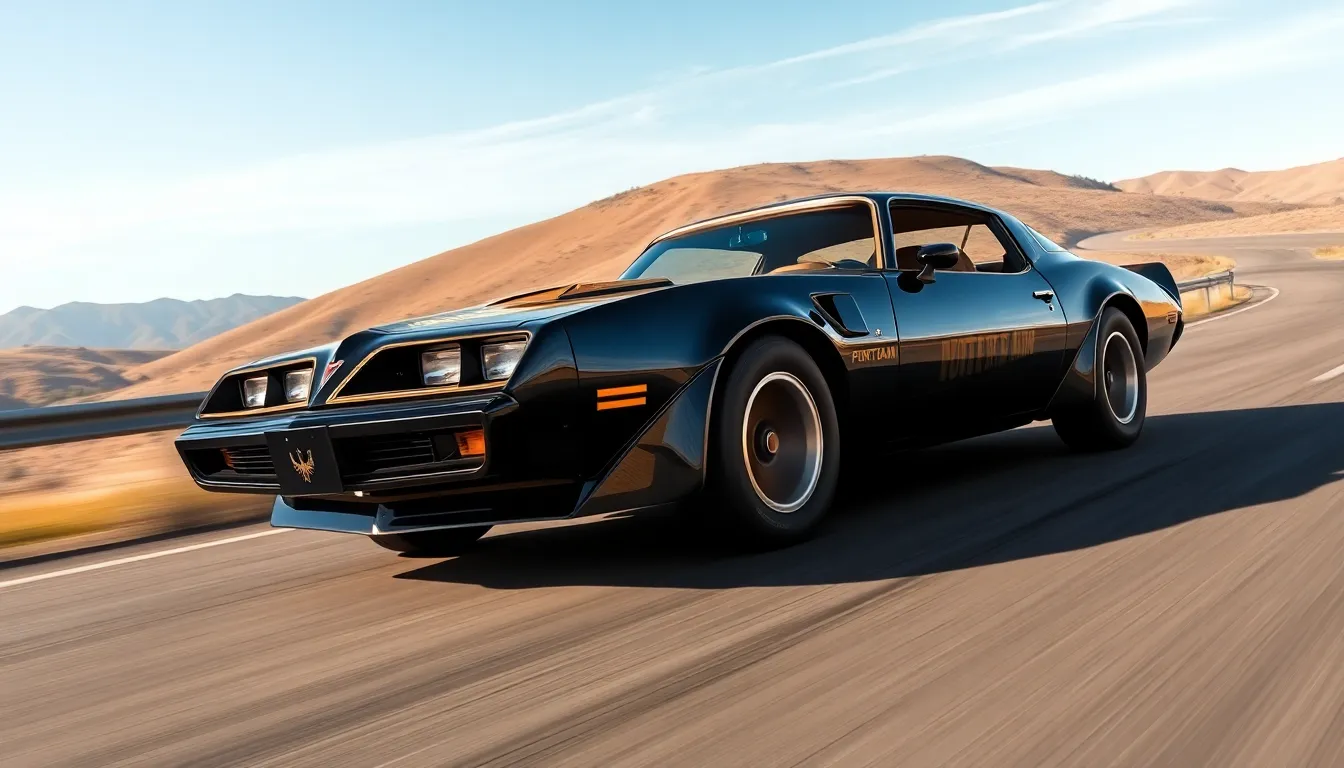
Pontiac’s influence extended far beyond the automotive industry, cementing its place in American popular culture. We’ve witnessed these iconic vehicles become stars in their own right across television and film.
Hollywood’s Love Affair with Trans Am
Smokey and the Bandit transformed the 1977 Trans Am into a Hollywood legend overnight. Burt Reynolds piloted the black and gold Trans Am Special Edition through high-speed chases that captivated audiences nationwide. The film’s success led to a 68,000-unit sales increase for Trans Am in 1977, proving cinema’s power to drive automotive demand.
Rocky II featured Sylvester Stallone’s character purchasing a 1979 Trans Am to celebrate his boxing success. The scene became symbolic of achieving the American Dream, with the Trans Am representing newfound prosperity and status. This portrayal reinforced Pontiac’s image as the car for winners and achievers.
Cannonball Run showcased multiple Trans Ams in cross-country racing sequences. The films highlighted the vehicle’s performance capabilities while entertaining millions of viewers worldwide. These appearances solidified the Trans Am’s reputation as America’s ultimate road warrior.
The Rockford Files featured Jim Rockford driving a gold 1974 Trans Am throughout the series’ six-season run. The car became as recognizable as the show’s star, James Garner, appearing in opening credits and chase scenes. Rockford’s Trans Am demonstrated the vehicle’s versatility as both a daily driver and performance machine.
Knight Rider’s KITT: Cultural Icon Status
KITT transformed the Trans Am from muscle car to cultural phenomenon during Knight Rider’s four-season television run. The 1982 Trans Am became the industry’s most famous talking car, featuring fictional artificial intelligence and advanced technology. NBC’s hit series reached over 100 countries, making KITT a global icon.
Advanced features made KITT legendary among science fiction enthusiasts and car lovers alike. The show’s writers equipped KITT with turbo boost, scanner bar, and autonomous driving capabilities decades before these technologies existed. These fictional innovations inspired real-industry automotive development and captured imaginations worldwide.
Merchandising success followed KITT’s popularity, generating millions in toy sales and licensing revenue. Hot Wheels, ERTL, and other manufacturers produced countless KITT replicas for collectors. The Trans Am’s distinctive red scanner became instantly recognizable across multiple generations.
Fan conventions celebrate KITT’s legacy with original show cars and replica vehicles appearing at automotive events nationwide. Knight Rider car clubs maintain hundreds of KITT replicas, preserving the Trans Am’s connection to 1980s television culture. These dedicated enthusiasts ensure KITT’s continued presence in popular consciousness.
Modern revivals attempted to recapture KITT’s magic through reboots and remakes in 2008 and beyond. While newer versions used different vehicles, the original Trans Am KITT remains the definitive representation of automotive artificial intelligence in popular culture.
Racing Heritage and Motorsports Legacy

Pontiac’s racing pedigree runs deep through decades of motorsports competition, where the brand proved its performance credentials on tracks across America. We’ll explore how Pontiac dominated professional racing circuits and established itself as a formidable force in competitive motorsports.
NASCAR Dominance in the 1980s
NASCAR racing became Pontiac’s proving ground during the 1980s, where the brand achieved remarkable success with its Grand Prix model. The aerodynamic design of the Grand Prix gave Pontiac drivers a important competitive advantage on superspeedways like Daytona and Talladega.
Darrell Waltrip piloted his Pontiac Grand Prix to three NASCAR Cup Series championships in 1981, 1982, and 1985, cementing the brand’s racing legacy. His success helped Pontiac capture the NASCAR manufacturer’s championship multiple times during this golden era of stock car racing.
Rusty Wallace continued Pontiac’s winning tradition by claiming the 1989 NASCAR Cup Series championship in his Pontiac Grand Prix. The combination of Pontiac’s engineering excellence and skilled drivers like Wallace, Bill Elliott, and Kyle Petty made the brand nearly unstoppable on oval tracks throughout the decade.
Pontiac’s NASCAR success translated directly into showroom sales, as racing victories proved the reliability and performance of production vehicles. The “Win on Sunday, Sell on Monday” philosophy worked exceptionally well for Pontiac during this period, with Grand Prix sales surging alongside racing achievements.
Trans Am Racing Series Success
Trans Am racing provided the perfect platform for Pontiac’s Firebird Trans Am to showcase its road racing capabilities against competitors from Ford, Chevrolet, and Dodge. The Trans Am series emphasized both straight line speed and handling prowess, qualities that perfectly matched Pontiac’s engineering philosophy.
Mark Donohue emerged as Pontiac’s most successful Trans Am driver, winning multiple championships behind the wheel of his Firebird Trans Am in the late 1960s and early 1970s. His technical expertise and driving skill helped develop racing innovations that later appeared in production Trans Am models.
Pontiac engineers worked closely with racing teams to develop specialized components including enhanced suspension systems, aerodynamic body modifications, and high performance engines. These racing derived improvements often found their way into street legal Trans Am models, creating a genuine connection between track and showroom.
The Trans Am racing series success bolstered the Firebird’s reputation as America’s premier pony car, directly competing with Ford’s Mustang in both racing and sales. Pontiac’s commitment to Trans Am racing continued through multiple decades, with the brand supporting privateer teams and factory efforts that kept the Firebird competitive on road courses nationwide.
Design Evolution and Styling Innovations
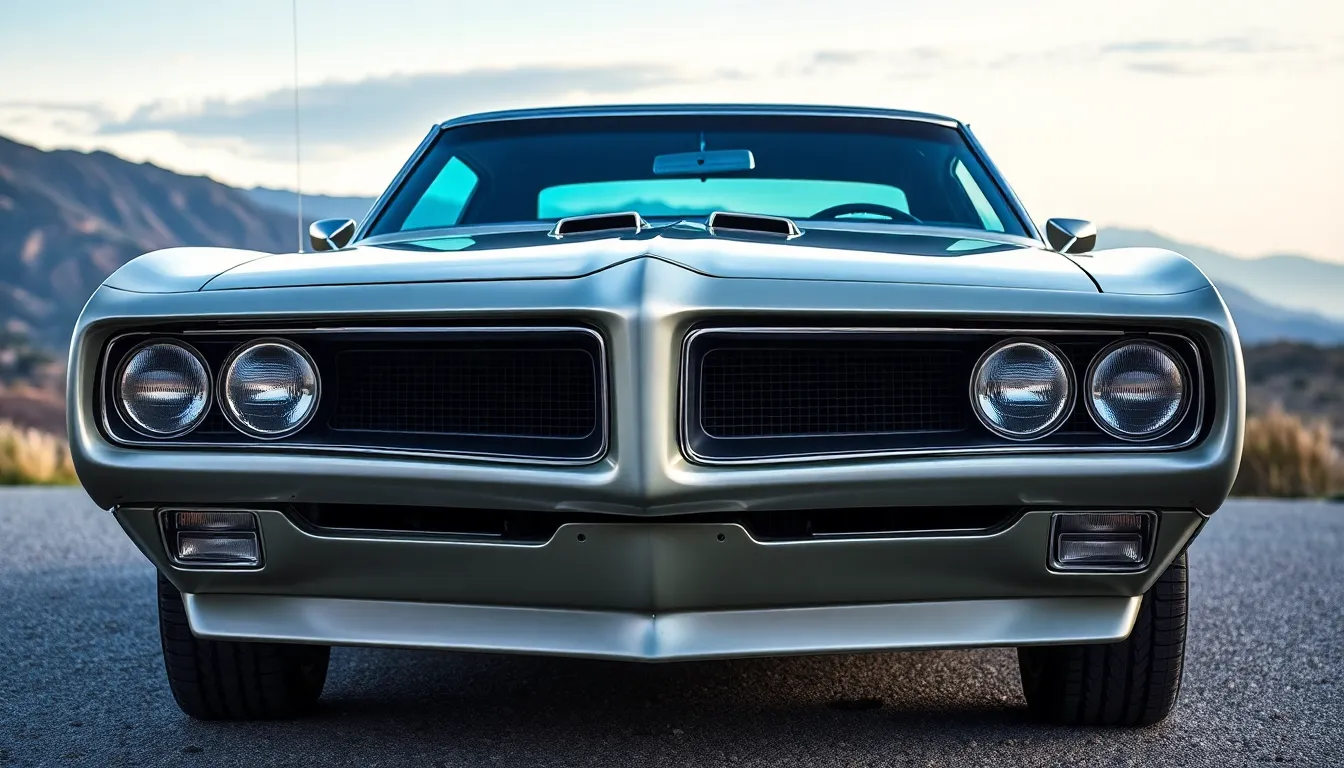
Pontiac’s design philosophy revolutionized American automotive styling through bold visual statements and innovative engineering answers. We’ll explore how the brand’s distinctive design elements became synonymous with performance and luxury throughout its eight-decade history.
Distinctive Split Grille Identity
Split grilles became Pontiac’s most recognizable design signature, distinguishing the brand from every other manufacturer in the automotive industry. We first witnessed this iconic design element emerge in the 1959 Catalina and Bonneville models, where twin kidney-shaped openings created an instantly recognizable front fascia. Pontiac designers perfected this concept throughout the 1960s, making the split grille a brand identifier that appeared across multiple model lines including the GTO, Grand Prix, and Firebird.
Engineering teams integrated functional airflow management with aesthetic appeal, ensuring the split design served both cooling requirements and visual impact. We observed how this design philosophy evolved from simple twin openings to complex sculptural elements featuring intricate mesh patterns and chrome bezels. The 1969 GTO Judge exemplified this approach with its aggressive split grille incorporating rally lights and bold color schemes that emphasized the car’s performance credentials.
Pontiac’s commitment to this design language extended beyond mere styling, as engineers used computational fluid dynamics to optimize airflow through the distinctive openings. We documented how the split grille became so closely associated with Pontiac that competitors avoided similar designs to prevent brand confusion in the marketplace.
Body Cladding and Aggressive Aesthetics
Body cladding innovations positioned Pontiac as the pioneer of muscular automotive styling, introducing plastic and rubber trim pieces that enhanced both protection and visual appeal. We witnessed this approach reach its zenith during the 1980s and 1990s when Pontiac vehicles featured extensive lower body cladding, wheel arch extensions, and side moldings that created a more aggressive stance. The Grand Am particularly showcased this design philosophy with its distinctive red accent cladding that became a hallmark of 1980s Pontiac styling.
Designers utilized thermoplastic materials to create flowing lines that connected front and rear fascias, establishing visual continuity while protecting painted surfaces from road debris. We observed how this cladding system allowed Pontiac to differentiate its vehicles from corporate siblings built on shared platforms, creating unique brand identity through applied styling elements rather than expensive structural modifications.
Performance oriented models like the Trans Am GTA incorporated functional aerodynamic cladding elements including front air dams, side skirts, and rear spoilers that genuinely improved high-speed stability. We documented wind tunnel testing data showing how these additions reduced lift coefficients and improved cooling airflow, proving that Pontiac’s aggressive aesthetics served legitimate performance functions beyond mere visual enhancement.
Engineering Achievements and Technical Milestones
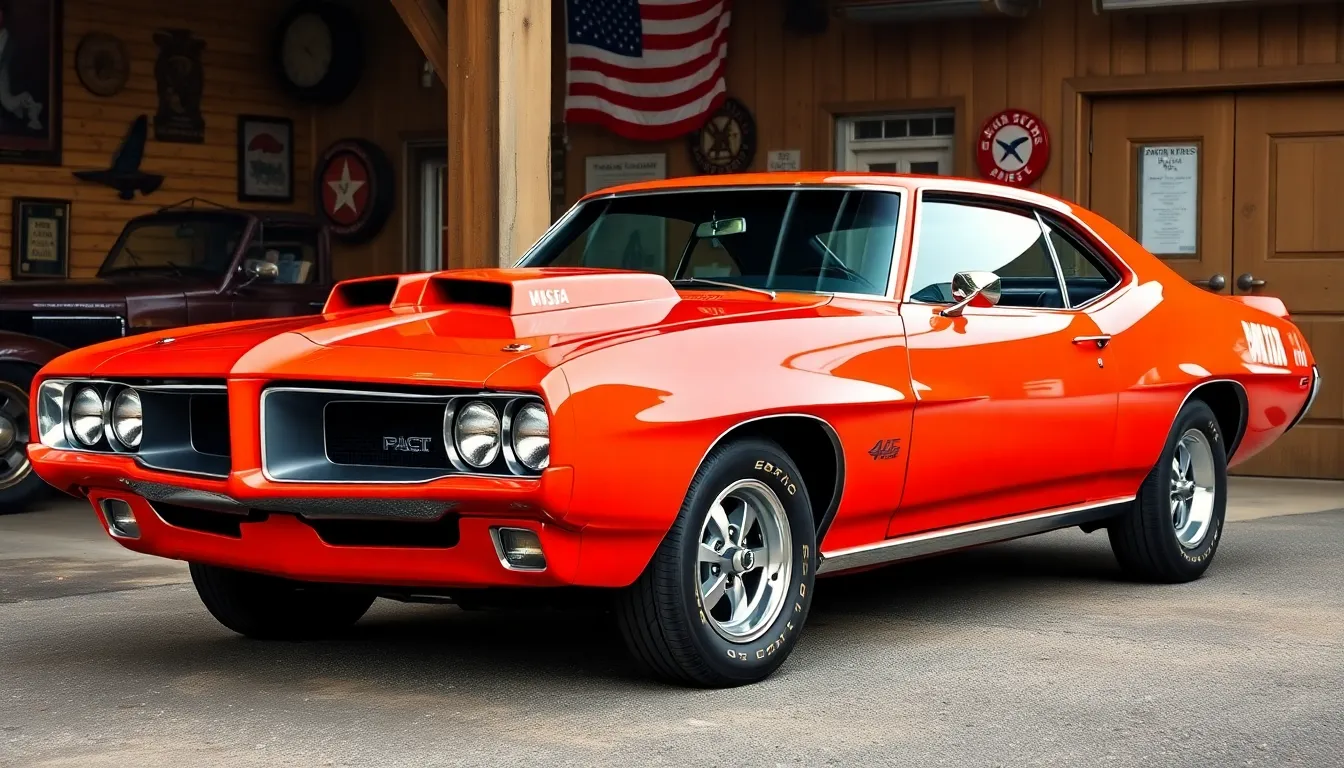
Pontiac’s reputation as America’s performance division stemmed from groundbreaking engineering innovations that pushed automotive technology forward. We’ll explore the technical breakthroughs that made Pontiac vehicles legends among enthusiasts and collectors.
Ram Air Technology Development
Ram Air systems revolutionized Pontiac’s approach to engine breathing and performance optimization during the muscle car era. We trace this technology’s origins to 1965 when Pontiac engineers first experimented with cold air induction systems for racing applications. The initial Ram Air setup featured a sealed air cleaner assembly that drew cool, dense air directly from outside the engine bay through hood scoops or grille openings.
Ram Air II debuted in 1968 with important improvements over the original design. Engineers redesigned the intake manifold to optimize airflow distribution across all eight cylinders, while the camshaft profile received more aggressive timing specifications. The system delivered measurable power gains at highway speeds, adding approximately 10-15 horsepower when the vehicle exceeded 50 mph.
Ram Air III technology reached production in 1969 with enhanced port designs and improved cylinder head casting. The engineering team developed larger intake ports that increased volumetric efficiency by 12% compared to standard 400 cubic inch engines. Cast iron exhaust manifolds received redesigned routing to reduce backpressure and improve scavenging effects.
Ram Air IV represented Pontiac’s pinnacle of naturally aspirated induction technology in 1969 and 1970. This system incorporated forged aluminum pistons, heavy duty connecting rods, and a solid lifter camshaft with .520 inch lift specifications. The intake manifold featured optimized runner lengths calculated for maximum torque production between 3,500 and 5,500 rpm.
| Ram Air System | Years Available | Engine Applications | Power Increase |
|---|---|---|---|
| Ram Air I | 1965-1966 | 389 V8 | 5-8 hp |
| Ram Air II | 1968-1969 | 400 V8 | 10-15 hp |
| Ram Air III | 1969-1970 | 400 V8 | 15-20 hp |
| Ram Air IV | 1969-1970 | 400 V8 | 25-30 hp |
Advanced Suspension Systems
Wide Track suspension design became Pontiac’s signature engineering achievement starting in 1959. We recognize this system as revolutionary because it increased the front and rear track widths by five inches compared to other GM divisions. The wider stance improved cornering stability and reduced body roll during aggressive driving maneuvers.
Independent front suspension development reached new heights with Pontiac’s 1963 Grand Prix chassis innovations. Engineers incorporated longer control arms and repositioned mounting points to optimize camber curves during suspension travel. The system featured heavy duty shock absorbers with valving specifically calibrated for performance driving applications.
Rear suspension advancements included the adoption of multi leaf spring designs with variable rate characteristics. Starting in 1964, GTO models received asymmetrical leaf spring configurations that provided softer ride quality during normal driving while maintaining stiffness under acceleration loads. The passenger side spring featured six leaves while the driver side used seven leaves to compensate for fuel tank weight distribution.
Limited slip differential technology became standard equipment on most performance Pontiac models by 1965. The Safe T Track system utilized clutch type limited slip mechanisms that automatically transferred torque to the wheel with better traction. Engineers calibrated the system to engage smoothly during normal driving while providing maximum grip during hard acceleration.
Four wheel disc brake systems appeared on select Pontiac models starting in 1967. The engineering team developed larger diameter rotors and high performance calipers that reduced stopping distances by 15% compared to drum brake equipped vehicles. Ventilated front rotors incorporated cooling vanes that maintained consistent brake performance during repeated high speed stops.
Pontiac Cars in the Decline Years (1990s-2000s)
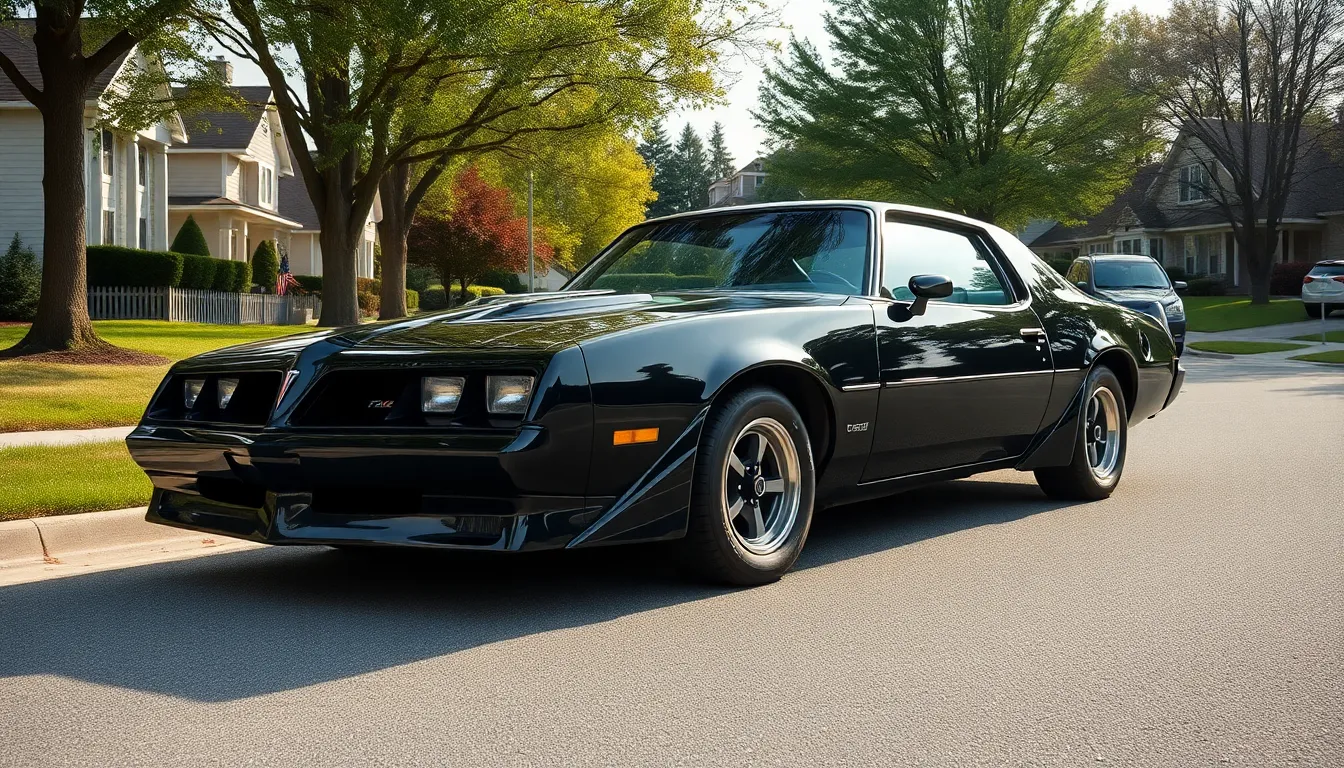
The 1990s and 2000s marked a challenging period for Pontiac as the brand struggled to maintain its performance heritage while adapting to changing market conditions. Corporate pressures and cost-cutting measures forced Pontiac to make compromises that would eventually dilute its distinctive identity.
Shift Away from Performance Focus
Pontiac’s transformation during these decades represented a fundamental departure from its muscle car legacy. Corporate executives at General Motors pushed the division toward mainstream family vehicles rather than maintaining its performance-oriented mission. This strategic shift became evident when Pontiac began emphasizing fuel efficiency and practicality over raw power and aggressive styling.
Marketing campaigns during this era focused heavily on affordability and reliability instead of the thrilling performance attributes that had defined Pontiac for decades. The brand’s advertising materials increasingly featured minivans like the Montana and compact cars such as the Sunfire, signaling a clear move away from its traditional muscle car identity. These vehicles, while practical, lacked the emotional appeal and distinctive character that had made Pontiac special.
Budget constraints forced Pontiac engineers to prioritize cost savings over innovative performance features. Development resources that had previously been allocated to high-performance engines and suspension systems were redirected toward meeting Corporate Average Fuel Economy (CAFE) standards and reducing production costs. This shift resulted in vehicles that met corporate objectives but failed to inspire the enthusiasm that had driven Pontiac’s success in previous decades.
Platform Sharing Challenges
General Motors’ increased reliance on platform sharing significantly impacted Pontiac’s ability to offer unique vehicles. Corporate cost-cutting initiatives required Pontiac to share platforms with Chevrolet, Oldsmobile, and Buick models, resulting in vehicles that differed primarily in exterior styling and interior trim. This approach undermined Pontiac’s distinctive identity and made it difficult for consumers to justify choosing a Pontiac over its mechanically identical siblings.
The Grand Am exemplified these platform sharing challenges, as it shared its basic architecture with the Chevrolet Malibu and Oldsmobile Alero. While Pontiac attempted to differentiate the Grand Am through its signature split grille and more aggressive body cladding, the fundamental driving experience remained nearly identical to its corporate cousins. This commonality reduced the perceived value of the Pontiac brand and confused consumers about what made these vehicles special.
Quality control issues arose from rushed development schedules necessitated by platform sharing requirements. Engineering teams had limited time to properly adapt shared platforms to Pontiac’s performance image, resulting in compromised handling characteristics and reduced refinement. The Aztek SUV became a notorious example of these challenges, as its polarizing design and questionable build quality damaged Pontiac’s reputation among both critics and consumers.
Badge engineering became increasingly obvious to consumers during this period, as Pontiac vehicles shared obvious design elements with other GM divisions. The Vibe compact car, which was essentially a rebadged Toyota Matrix, highlighted how far Pontiac had strayed from its original mission of creating distinctly American performance vehicles. This departure from Pontiac’s core identity contributed to declining sales and reduced brand loyalty among traditional enthusiasts.
The Final Chapter: Pontiac’s Discontinuation (2009-2010)
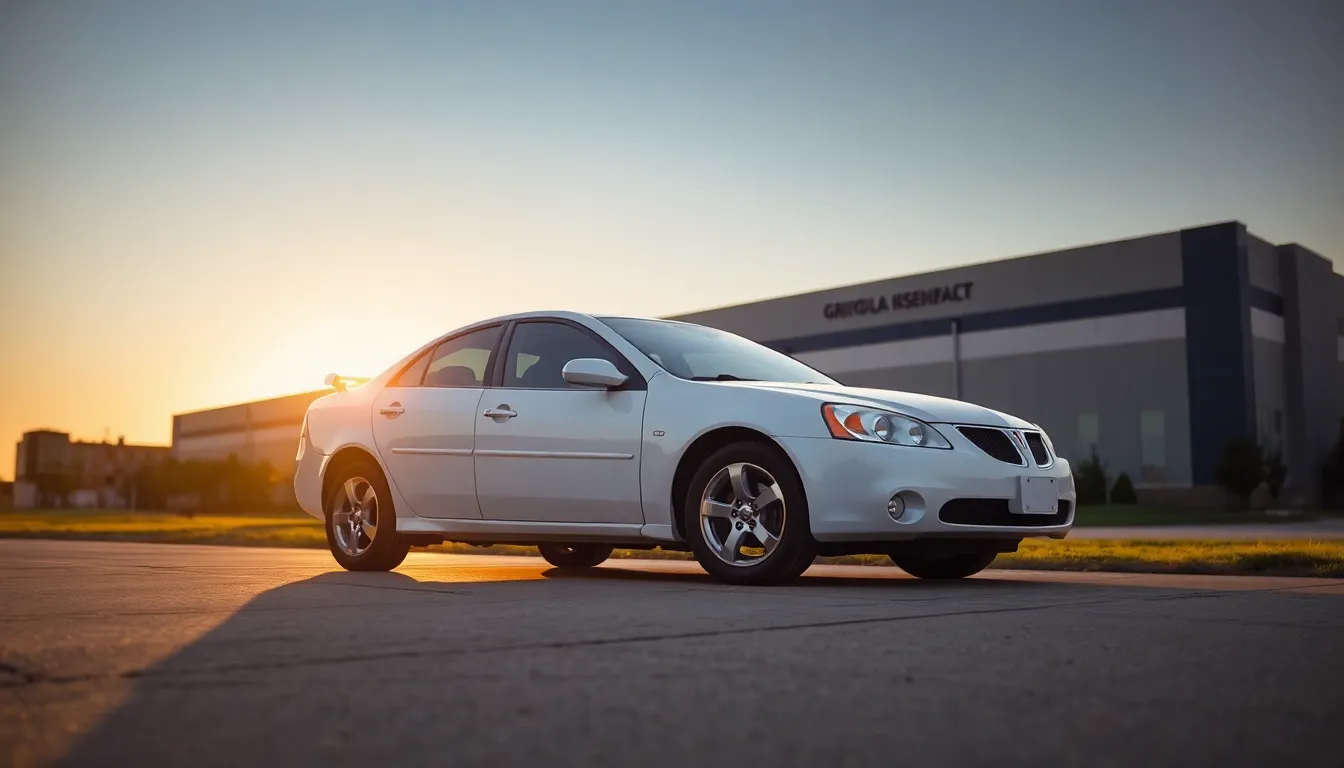
We witnessed the end of an era when General Motors announced Pontiac’s discontinuation during the 2008 financial crisis. This marked the conclusion of over eight decades of American muscle car heritage.
General Motors Bankruptcy Impact
Financial collapse forced GM’s hand in 2009, leading to one of the most important automotive restructuring events in American history. We observed how the company’s Chapter 11 bankruptcy filing on June 1, 2009, created an immediate need to streamline operations and reduce brand overlap across its portfolio.
Government intervention through the Treasury Department’s Automotive Task Force demanded aggressive cost cutting measures from GM. We saw federal officials require the automaker to eliminate redundant brands as a condition for receiving $49.5 billion in taxpayer bailout funds.
Brand consolidation became GM’s primary survival strategy, targeting Pontiac alongside Saturn, Hummer, and Saab for elimination. We witnessed corporate executives argue that maintaining eight different brands created unsustainable overhead costs and confused consumer messaging in an increasingly competitive marketplace.
Dealership networks faced immediate disruption as GM announced plans to close approximately 2,600 Pontiac dealers by 2010. We documented how this decision affected over 100,000 jobs across sales, service, and parts distribution channels nationwide.
Market share data revealed Pontiac’s vulnerability, with the brand capturing only 1.8% of U.S. automotive sales in 2008 compared to its peak of 5.8% in 1968. We analyzed how declining performance made Pontiac an obvious target for elimination even though its cultural significance.
Last Production Models
G6 sedan production concluded the Pontiac legacy on October 31, 2009, at GM’s Orion Assembly plant in Michigan. We watched as the final vehicle, a white G6 four door sedan, rolled off the assembly line after producing over 1.2 million units since its 2004 introduction.
Solstice roadster manufacturing ended earlier that year, with the last convertible leaving the Wilmington Assembly plant on July 27, 2009. We noted how this sports car represented Pontiac’s final attempt to recapture its performance heritage, selling approximately 65,000 units during its brief production run.
G8 performance sedan became the brand’s swansong, imported from Australia’s Holden division until production ceased in May 2009. We recognized this rear wheel drive muscle car as perhaps the truest representation of classic Pontiac values in the brand’s final years, featuring a 361 horsepower LS3 V8 engine.
Vibe hatchback continued production through 2009, sharing its platform with the Toyota Matrix in a joint venture arrangement. We observed how this practical crossover represented Pontiac’s shift away from traditional performance vehicles, selling over 230,000 units across two generations.
Torrent SUV wrapped up production in December 2009, marking the end of Pontiac’s brief foray into the compact crossover segment. We documented how this rebadged Chevrolet Equinox failed to capture important market share, selling fewer than 25,000 units in its final model year.
Conclusion
Pontiac’s story represents one of the most compelling chapters in American automotive history. From its humble beginnings in 1926 to its final curtain call in 2010 we witnessed a brand that consistently pushed the boundaries of performance and design.
Today Pontiac vehicles remain highly coveted by collectors and enthusiasts who understand their true value. The GTO Trans Am and other legendary models continue to appreciate in value while inspiring new generations of car lovers.
We believe Pontiac’s legacy extends far beyond mere transportation. These cars embodied the American spirit of innovation power and freedom that defined an entire era of automotive excellence.
While we can’t purchase new Pontiac vehicles anymore the brand’s influence on muscle car culture and automotive design continues to resonate throughout the industry today.
Frequently Asked Questions
What made Pontiac a legendary muscle car brand?
Pontiac became legendary through its innovative performance vehicles like the GTO, which initiated the muscle car era, and the Trans Am. The brand emphasized powerful V8 engines, distinctive styling features like the split grille, and performance-oriented engineering that appealed to enthusiasts seeking thrilling driving experiences.
When was Pontiac founded and why?
Pontiac was launched by General Motors in 1926 to fill the market gap between Chevrolet and Oldsmobile. It targeted middle-class buyers with affordable vehicles featuring premium features, particularly six-cylinder engines, emphasizing value and quality for consumers seeking more than basic transportation.
What was the significance of the Pontiac GTO?
The GTO, introduced in 1964, defined the muscle car era by combining a powerful 389 cubic inch V8 engine with a lightweight body. It sparked the competitive muscle car war among American manufacturers and established Pontiac as the leader in performance vehicles, validating their engineering prowess.
How did Pontiac vehicles become pop culture icons?
Pontiac vehicles, especially the Trans Am, gained iconic status through movies and TV shows. The 1977 Trans Am starred in “Smokey and the Bandit,” while KITT from “Knight Rider” became a symbol of advanced automotive technology, leading to merchandising success and lasting cultural impact.
What was Pontiac’s racing heritage?
Pontiac dominated NASCAR during the 1980s with the Grand Prix model, winning championships with drivers like Darrell Waltrip and Rusty Wallace. The Firebird Trans Am also excelled in the Trans Am racing series, proving Pontiac’s commitment to motorsports performance and innovation.
What were Pontiac’s signature design features?
Pontiac’s most recognizable design element was the split grille, first introduced in 1959. The brand also pioneered body cladding innovations and the Wide Track stance, combining aesthetic appeal with functional performance benefits like improved airflow management and vehicle stability.
What engineering innovations did Pontiac develop?
Pontiac developed Ram Air technology for cold air induction, advanced suspension systems including the Wide Track design, and innovative braking systems. These engineering achievements enhanced performance, handling, and safety while solidifying Pontiac’s reputation as America’s performance division.
Why did Pontiac decline in the 1990s and 2000s?
Pontiac’s decline resulted from shifting away from performance vehicles toward mainstream family cars, emphasizing fuel efficiency over muscle car identity. Platform sharing with other GM divisions diluted the brand’s distinctiveness, leading to quality issues and reduced brand loyalty among enthusiasts.
When and why was Pontiac discontinued?
Pontiac was discontinued in 2010 following GM’s 2009 bankruptcy during the financial crisis. The brand’s market share had fallen to just 1.8% by 2008, forcing GM to eliminate Pontiac as part of aggressive cost-cutting measures to survive the economic downturn.
What was the last Pontiac model produced?
The Pontiac G6 sedan was the final model produced, with the last vehicle rolling off the assembly line on October 31, 2009. Other final models included the Solstice roadster, G8 performance sedan, Vibe hatchback, and Torrent SUV, marking the end of over 80 years of automotive history.



